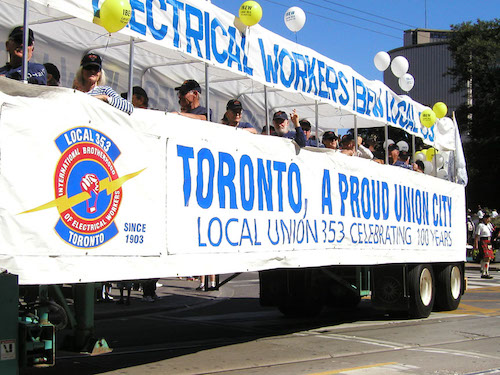Early last year, news reached Toronto Local 353 that CEC Services Ltd., based in nearby Aurora, Ontario, was looking to buy an IBEW-signatory contractor through its parent company, the Beswick Group of Companies.

|
A banner for Toronto Local 353 during an Ontario Labour Day Parade.
Flickr/Creative Commons photo by ardenstreet.
|
That caught the attention of Local 353 organizers, who thought for some time the CEC would be a natural fit in the IBEW. It’s an electrical services contractor with a history of successful projects in constructing hospitals and long-term care facilities, according to the company’s website.
The problem was that its employees already had representation, albeit from an organization not necessarily looking out for its best interests.
They were aligned with the Christian Labour Association of Canada, which critics charge is a trade union in name only because it often negotiates contracts favorable to management. Canadian labour activists often call them “fake unions.” Local 353 approached the employees about representation many years earlier but they voted to side with CLAC in 2005 and stayed with it ever since. Attempts since then didn’t gain much traction.
There was a glimmer of hope, however. The agreement negotiated with the labour association was expiring at the end of the year, so by provincial law, Local 353 and other unions had the right during November and December to approach CEC Services employees about new representation. The final two months of a contract are commonly called the “open period” by organizers.
Led by Membership Development Coordinator Gord Nye and Membership Development Representative Andrew White, the effort convinced CEC electricians to agree to IBEW representation over CLAC, adding about 70 new members in and around Toronto.
“The moral of the story is to be patient and hang in there,” said Bill Martindale, a First District organizer for Eastern Canada who was a Local 353 organizer for many years before joining the district staff. “You never know what will happen.”
First District Vice President Thomas Reid praised everyone involved for being aggressive when they saw a chance to strike an agreement with Beswick, one of the more successful contractors in the Toronto area.
“Growing our construction membership in Canada is difficult during this pandemic,” Reid said. “I couldn’t be more proud of everyone at Local 353 for their work on this drive. Our organizers saw an opening and built relationships with the CEC employees and management quickly realized we offered an upgrade over their previous agreement.
“I also want to thank Bill and all our staffers who kept this company on our radar over the years. Successful organizing drives usually don’t happen overnight and this certainly is proof of that.”
Nye and White did much of the legwork on the campaign. It started with a card-signing effort to ensure they were accessible to all the potential new members.
“When we met with them, we heard how pleased they were that we were treating them with respect,” Nye said. “The conversations were candid and open. They were not afraid to ask tough questions. We were happy to answer their questions anytime, day or night.”
Those CEC employees were spread over an area that stretched about two hours outside Toronto in each direction. There were days when Nye and White drove more than 400 kilometers in and around Canada’s largest city to meet with workers. Upon arriving at the jobsite, they observed social distancing requirements and used the appropriate PPE during the COVID-19 pandemic.
White said the employees made it clear they were not upset with CEC management. Rather, they were with disappointed with CLAC, which they saw as increasingly out of touch.
For instance, CLAC normally negotiates different wage rates for each bargaining unit it represents in Ontario. The IBEW negotiates a province-wide agreement binding upon all its signatories, something that struck the CEC employees as more fair.
“They mentioned numerous times what pleasant experiences they’ve had (with the company], which sometimes is rare for us to hear,” he said. “They spoke not just highly of each other but also the contractor. For them, there was no fear of retribution from management.”
They knew their employer well. CEC management accepted the new representation quickly, Nye said, especially after the IBEW showed how potential new wage rates would not have a negative impact on their costs. Local 353 also agreed to accept apprentices in the CLAC training programs as they were. Their hours worked would count and they wouldn’t be compelled to do upgrading as a condition of employment.
Apprentices in the CLAC training programs were admitted into Local 353’s apprenticeship program, with instructors judging how far along they were in their studies.
“The [Local 353] training director is a taskmaster,” Martindale said. “He will tell them when they have to have more safety training. He will tell them when they have to have upgrades.”
Martindale also gave credit to James Barry, the executive secretary/treasurer of the Ontario Construction Trades Council and a former business manager of Ottawa Local 586, for his assistance with the drive. Nye and White were assisted by newly-elected Local 353 Business Manager Lee Caprio.
“I welcome the CEC employees to the brotherhood and thank them for their confidence,” Reid said. “This serves as inspiration for other Ontario electrical workers represented by so-called unions that really are more interested in servicing management. You can make a change for the better during your open period. Our organizers will meet with you any place at any time to make that happen. “